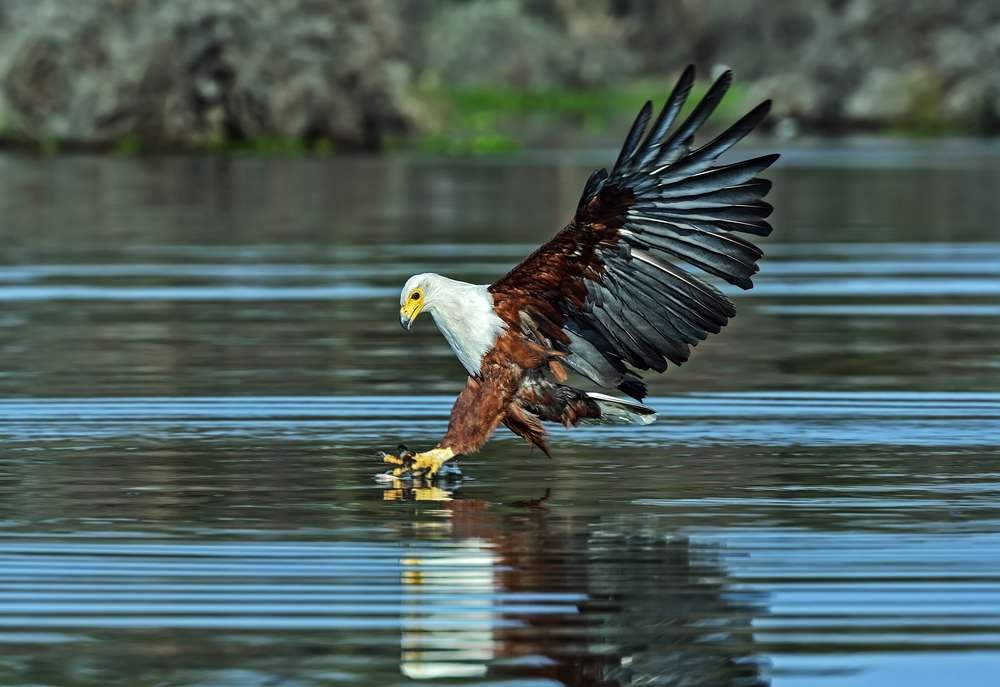African Fish Eagle
( Nkwazi or African sea eagle )
- Haliaeetus vocifer
- IUCN Status: Least Concern
- Trend: stable

- Phylum: Chordata
- Class: Aves
- Order: Accipitriformes
- Family: Accipitridae
- Genus: Haliaeetus
Share:
General Information
The African Fish eagle has been called by many to be the symbol of Africa. It is a skilled hunter that can catch fish up to twice its own size. It is closely related to the American bald eagle and is one of the oldest species of birds in existence.
Fun Facts!
The African Fish Eagle is the national bird of Zambia. It is also on the Zambian Coat of arms and the Zambian national Flag. It also appears both as the national bird and on the coat of arms of several other African countries including Namibia, Zimbabwe and South Sudan. They can carry 10 times their own body weight
Description
It is a large bird with thr females being larger than the males. It has mostly brown body with a white head and large, powerful, black wings. The head, breast, and tail of African fish eagles are snow white, with the exception of the featherless face, which is yellow. The eyes are dark brown. The hook-shaped beak, ideal for a carnivorous lifestyle, is yellow with a black tip
- Wingspan: up to 2.4 m
- Weight: 2-2.5 kg (males) | 3.2-3.6 kg (females)
- Lifespan: up to 40 yrs in the wild
Ecology and Behaviour
Its distinctive cry is, for many, evocative of the spirit or essence of Africa. The call, shriller when uttered by males, is a weee-ah, hyo-hyo or a heee-ah, heeah-heeah.
Diet
They are proficient hunters and can carry prey that’s up to 10 times its own body weight. They primarily hunt on Fish. Hunting from a high perch, they watch for a fish to move to the water’s surface. Once sighted, they then swoop low over the water, throwing both feet forward to seize the prey with their powerful talons. Although only about one in seven attempts are successful, they only spend about 10 minutes actively hunting each day. They can also be very opportunistic and eat young water-birds and occasionally will eat crocodile hatchlings, frogs, insects, ducks and even small monkeys.
Reproduction
Fish Eagles mate for life and can normally be seen in pairs, calling and dueting. This is an integral part of their breeding display, along with spectacular aerial dives and falls, in which mating pairs can be seen interlocking their talons in mid-air. Females lay one to three eggs, which are then incubated for about 44 days. Both adults care for the chicks until they fledge at about 65-75 days.
Conservation
It is categorized by the International Union for Conservation of Nature as a, “Least Concern” and their numbers are stable throughout the region.
Distribution and Habitat
This species is common near lakes, reservoirs, rivers and other large water-bodies. The African fish eagles are indigenous to sub-Saharan Africa, ranging over most of continental Africa south of the Sahara Desert.
Interaction with humans
Their population is seen as stable, although wetland degradation and water pollution is thought to have affected their numbers over the years.
No donation to this project yet.
| M | T | W | T | F | S | S |
|---|---|---|---|---|---|---|
| 1 | 2 | 3 | ||||
| 4 | 5 | 6 | 7 | 8 | 9 | 10 |
| 11 | 12 | 13 | 14 | 15 | 16 | 17 |
| 18 | 19 | 20 | 21 | 22 | 23 | 24 |
| 25 | 26 | 27 | 28 | 29 | 30 | |


